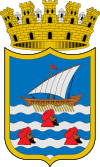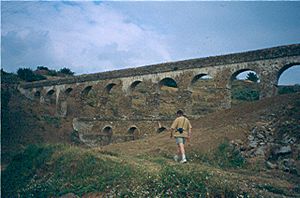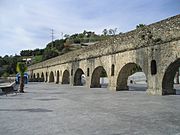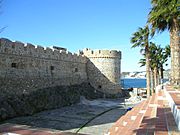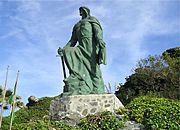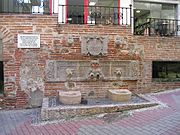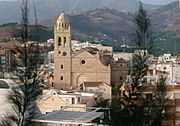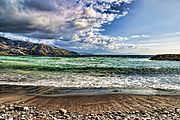Almuñécar facts for kids
Quick facts for kids
Almuñécar
|
|||
|---|---|---|---|
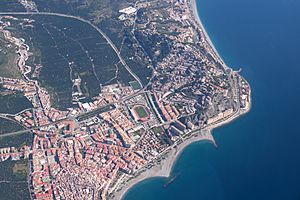
Almuñécar
|
|||
|
|||
 |
|||
| Country | |||
| Autonomous community | |||
| Province | Granada | ||
| Comarca | Costa Granadina | ||
| Judicial district | Almuñécar | ||
| Founded | ~800BC | ||
| Area | |||
| • Total | 83.36 km2 (32.19 sq mi) | ||
| Elevation | 24 m (79 ft) | ||
| Highest elevation | 87 m (285 ft) | ||
| Lowest elevation | 0 m (0 ft) | ||
| Population
(2018)
|
|||
| • Total | 26,377 | ||
| • Density | 316.423/km2 (819.53/sq mi) | ||
| Demonyms | Sexitano, -na o almuñequero, -ra |
||
| Time zone | UTC+1 (CET) | ||
| • Summer (DST) | UTC+2 (CEST) | ||
| Postal code | |||
Almuñécar is a city and town located in the southern part of Spain, in the province of Granada. It sits right on the Mediterranean Sea. The city is surrounded by other towns like Otívar and Nerja. The Verde river also flows through its area. Almuñécar includes smaller towns like La Herradura and Velilla-Taramay.
Since the 1970s, Almuñécar has become a very popular place for tourists in the Granada province. It has good ways to get around and even a football (soccer) stadium.
Almuñécar is mentioned in the book As I Walked Out One Midsummer Morning by Laurie Lee. The book talks about the start of the Spanish Civil War.
The city's special symbol, its coat of arms, shows the heads of three pirates floating in the sea. King Carlos I gave this symbol to the town in 1526. It was to celebrate Almuñécar defeating a group of Berber pirates.
Contents
Discovering Almuñécar's Past
Almuñécar started as an ancient settlement called Sexi. It was founded by the Phoenicians. Even today, some people from Almuñécar call themselves Sexitanos. Later, under the Moors, the town grew into a busy fishing port called al-Munakkab. For a long time, people knew about the Phoenician and Roman history from old writings. But it wasn't until the 1950s that archaeologists found important proof of this history.
Ancient Times in Almuñécar
Phoenician Settlers
The Phoenicians first built a colony in Almuñécar around 800 BC. This colony grew for 600 years into an important port and town called Ex or Sexi. It was famous for its large fish salting and curing industry. This industry supplied fish to places like Greece and Rome. They also made a special fish paste called garum. This paste was made from fish parts through a process called fermentation.
Archaeologists have found a lot of evidence from Phoenician cemeteries. These include the Laurita necropolis and the Punte de Noy necropolis. Many Phoenician items found in graves are now on display. You can see them in the town museum at the Castle of San Miguel and in the 'Cueva de Siete Palacios'.
Roman Influence
The Romans arrived in southern Spain in 218 BC during the Second Punic War. They wanted to take control of the Phoenician settlements along the coast. For 700 years, the town and its industries thrived under Roman rule. In 49 BC, Almuñécar was given the special title Firmium Julium Sexi. This was to honor the town's loyalty to Rome.
During the 1970s and 1980s, archaeologists found a lot of evidence of the fish salting and curing industry. This was discovered in the large Majuelo Botanical Gardens. These findings showed how much the industry grew and improved under the Romans. A part of the site has been saved, showing how big this industry was. This industry needed a lot of fish, sea salt, and fresh running water.
To get water, the Romans built four miles of water pipes in the 1st century AD. These pipes were in the valleys of the Rio Seco and the Rio Verde. They included five important aqueducts. Amazingly, all of them are still standing today. Four of them are still used after 2,000 years! The Moors later changed them to help water crops. The Roman water system also supplied the town. Recent digs in the town center have found the fifth aqueduct and Roman baths.
The Romans likely built the first defenses for the Castle of Saint Miguel. However, many rebuilds have covered up most of the Roman walls. These defenses included a bridge from the castle to the 'Peñon del Santo'. This bridge had a huge 100-foot-high arch that lasted until at least 1800.
Below the castle, on the land side, is the 'Cueva de Siete Palacios'. This means 'Cave of the Seven Palaces'. But it's not a real cave. It's the largest part of a Roman palace found in Almuñécar. It was used as homes for hundreds of years until the 1970s. Only then did people realize its true Roman origins. It now holds the town museum. Other important Roman remains include a Roman bridge at Cotobro and Roman tombs.
Middle Ages in Almuñécar
Visigoth Rule
After the Roman Empire declined in the 5th century, Germanic groups like the Visigoths came into Spain. By 456, the Visigoths became the main power. They took over the southwestern Mediterranean coast. However, Spain remained quite Roman under their rule. The Visigoths adopted Roman culture and language. They also kept many old Roman ways. But much of the economy fell apart, and the fish curing industry in Almuñécar quickly declined.
Muslim Influence
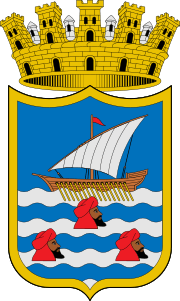
In 755, Umayyad leader Abd ar-Rahman I arrived from North Africa. He came to create his kingdom. The castle stayed the main fort of the city and the center of government. Its walls were made stronger. Many dungeons were built for those who upset the local rulers. But baths were also built for important people during the al-Andalus period.
The cross on Peñon del Santo, a rock at the old harbor entrance, marks the defeat of the Arabs. It shows their surrender at Almuñécar. This led to the area becoming part of the Kingdom of Castille in 1489. The Arabic name المُنَكَّب (al-Munakkab), meaning "surrounded by mountains," is where the name Almuñécar comes from today.
Modern Almuñécar
After Christian rule returned, new buildings were made. For example, a new church was started in 1557 and finished in 1600. It was the first Baroque-style church in the Granada province. The old town also saw changes. A water fountain was built on Calle Real (Royal Street) in 1559. It used the Roman water supply from Las Angosturas, which was 1500 years old!
The castle was rebuilt and made much stronger. King Charles III protected it under the name of San Miguel. It was last defended by the French during the Napoleonic Wars. Only one tower was partly destroyed, but most of the inside buildings were also ruined. This happened when a British ship, HMS Hyacinth, worked with Spanish fighters from Nerja on May 27, 1812. They made the French soldiers run away. They tried to make the castle unusable, but didn't succeed much because the gunpowder was wet.
The castle was no longer a military fort. After a cholera outbreak in 1830, it became the town cemetery. It was cleared in 1986 to allow for restoration work, which is still happening.
In 1562, a Spanish fleet sank in a storm in La Herradura Bay. This was known as the La Herradura naval disaster.
In the summer of 1936, at the start of the Spanish Civil War, the English writer Laurie Lee was rescued by the Royal Navy here. This story is in his book, As I Walked Out One Midsummer Morning.
Since the 1970s, the town's economy has grown a lot. This is thanks to more people visiting from Spain and other countries.
Delicious Food in Almuñécar
Almuñécar's food mainly uses fresh fish and fruits from warm climates. Some popular local seafood dishes include monkfish, red sea bream, squids, grouper, and shellfish paella. There are many restaurants by the beach where you can eat these meals al fresco (outside) and enjoy the sea breeze. Going on "tapas crawls" is also popular. This means visiting several bars to try different tapas (small dishes).
The soil in the area is very rich. Because of the warm, almost tropical weather, many tropical fruits can grow here. The most famous ones are mangos, avocados, loquats, and cherimoyas. You can also easily find papayas, guavas, lychees, kiwis, figs, and even prickly pears. Prickly pears are the fruit of the Opuntia ficus-indica cactus. They are used to make ice cream and jams sold in local coffee shops.
Until the 1960s, Almuñécar was also an important place for growing sugar cane.
Some traditional dessert cakes still made locally are:
- Cazuela Mohína: An almond cake made with brown sugar, sesame, and aniseed.
- Torta de Alhajú: An almond cake wrapped in thin wafers and honey.
- Merengazo: A sponge cake topped with egg white meringue.
How to Get to Almuñécar
By Road: You can reach Almuñécar using the coastal highway A7. This road connects from Almería in the east and Malaga in the west. If you are coming from the north, you can get to Almuñécar using the A-44 highway. This road is also known as Autovía de Sierra Nevada-Costa Tropical.
By Train: Unfortunately, there are no train stations close to Almuñécar.
By Sea: Almuñécar has a small marina called Marina del Este. You can reach it with private boats. Another option is the Port of Motril, which is less than 20 kilometers away. This port offers ferry services and even cruises.
By Air: Almuñécar does not have its own airport. However, there are two airports within about 90 kilometers. These are Federico Garcia Lorca Airport in Granada-Jaen (GRX) and Malaga - Costa del Sol Airport (AGP). Both airports have bus services that connect to their cities.
Malaga Airport is usually the easiest airport to use for Almuñécar. It has the most flight connections and is one of the busiest airports in Spain. Granada Airport is smaller and has fewer international flights. From Malaga Airport, you can take a direct bus to Almuñécar from the bus station in Malaga. Taxis are also available at Terminal 3. A taxi from Malaga Airport to Almuñécar usually costs around 130 to 150 euros. This price can change based on the day, time, and traffic. You can also find several car rental companies at the airport. There are also private transfer services from Malaga Airport that you can book ahead of time. There are no shared shuttle services available.
Gallery
International Connections
Twin Towns and Sister Cities
Almuñécar is connected with these cities around the world:
|
|
See also
 In Spanish: Almuñécar para niños
In Spanish: Almuñécar para niños



